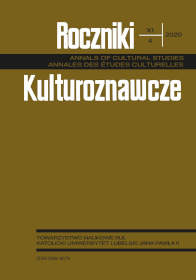A Look at Medieval Aesthetics under the Backlight of Contemporary Aesthetics
Abstract
The Author of this essay tries to show the value of medieval aesthetics by putting it in dialogue with some fundamental aspects of contemporary aesthetics. A description of those issues that most contrast with current culture is outlined: the predominance in the Middle Ages of religious faith and its fusion with the tradition of Greek thought in a metaphysical perspective, in order to elaborate the aesthetic theory, developing an ontological theory of beauty and art. On the contrary, the current era, still very indebted to modernity, is installed in a position of enormous metaphysical fragility and religious faith, excessively restricting reason to scientific rationality. In this sense, the Middle Ages can inspire us in the quest, already undertaken by certain currents of phenomenology, of expanding reason. In this framework, the difficulties of medieval aesthetics in order to conceive clearly the difference between beauty and good are analysed, then it has been something that has been done better in modern lines that have not lost the transcendental, from Immanuel Kant to Xavier Zubiri. Various conceptions of the Middle Ages are asserted, fundamentally from the hand of Umberto Eco, and without idealizing it, important values stand out in it nonetheless. The thesis is defended that it is not possible to completely renounce the theory of proportion, but that it must be expanded on the basis of a richer ontology, which, together with the ‘real-things’ of the world, takes into account the ‘sense-things’, according to the proposal of Xavier Zubiri. This allows us to critically assume the expansion of the aesthetic horizon (the opening of aesthetic values) typical of the contemporary without falling into nihilism.
References
Agustín (San). De Trinitate. Escritos apologéticos (2.º): La Trinidad. Madrid: BAC, 2006.
Agustín (San). La ciudad de Dios, vol. II. Madrid: BAC, 1988.
Alberto Magno (San). Comentario a “De los nombres divinos” de Dionisio Areopagita. Magni Ordinis Fratrum Praedicatorum Super Dionysium De divinis nominibus. Münster 1972: Paulus Simon (Monasterii estfalorum: In aedibus Aschendorff) p. 180, v. 82 – p. 197, v. 26 [§§ 71–94] (Traducción de David Torrijos).
Aristóteles. Metafísica. Traducción de Valentín García Yebra. Madrid: Gredos, 1998.
Benjamin, Walter. Das Kunstwerk im Zeitalter seiner technischen Reproduzierbarkeit. Drei Studien zur Kunstsoziologie. 34. Aufl. Frankfurt am Main: Suhrkamp, 2015 (1. Aufl. 1935). Traducción española: La obra de arte en la época de su reproductibilidad técnica. Traducción de Alfredo Brotons Muñoz. Madrid: Abada, 2018).
Chaignet, Anthelme. Pythagore et la philosophie pythagoricienne. Contenant les fragments de Philolaüs et Archytas. Paris: Didier et Cie, 1873.
Danto, Arthur. El abuso de la belleza: La estética y el concepto del arte. Barcelona: Ediciones Paidós 2011.
Dicki, George. Introduction to Aesthetics: An Analytic Approach. New York: Oxford University Press, 1997.
Eco, Umberto. Arte y belleza en la estética medieval. Traducción de Helena Lozano Miralles. Barcelona: Debolsillo, 2012.
Eco, Umberto. “Dieci mode di sognare el Medioevo”. En Umberto Eco. Scritti sul pensiero medievale, 1093–1108. Milano: Bompiani/RCS Libri 2016.
Heidegger, Martin. Sein und Zeit. Tübingen: Max Niemeyer Verlag, 1986.
Huizinga, Johan. El otoño de la Edad Media. Studios sobre las formas de la vida y del espíritu durante los siglos XIV y XV en Francia y en los Países Bajos. Traducción de José Gaos. Madrid: Revista de Occidente, 1930.
Husserl, Edmund. Die Krisis der europäischen Wissenschaften und die transzendentale Phänomenologie. Zweiter Teil: Die Ursprungsklärung des neuzeitlichen Gegensatzes zwischen physikalistischen Objektivismus und transzendentalem Subjektivismus. Husserliana VI. The Hague: Martinus Nijhoff, 1976.
Kant, Immanuel. Crítica del juicio [Kritik der Urteilskraft]. Traducción de Manuel García Morente. Madrid: Espasa Calpe, 1981.
Kant, Immanurl. Kritik der Urteilskraft. Einleitung 4. Sttutgart: Reclam 1986 (Traducción de Garcia Morente. Madrid: Espasa Calpe, 1981).
Marenborn, John. “Medieval and Renaissance Aesthetics”. En A Companion to Aesthetics, edited by Stephen Davies, Kathleen Marie Higgins, Robert Hopkins y Robert Stecker, David E. Cooper, 22–28. Malden/Oxford: Blackwell 2009.
Marion, Jean-Luc. Étant donné. Essai d’une phénoménologie de la donation. Paris: PUF, 1997
Marion, Jean-Luc. De surcroît. Études sur les phénomènes saturés. Paris: PUF-Quadrige, 2010.
O’Connell, Robert J. Art and the Christian Intelligence in Saint Augustin. Cambridge: Harvard University Press, 1978.
Platón. Diálogos, vol. III: Fedro. Madrid: Gredos, 2020.
Platón. Diálogos, vol. I: Hipias mayor. Madrid: Gredos, 2020.
Plotino. Sobre la belleza. Traducción de Agustín López y María Tabuyo. Barcelona: El Barquero, 2007.
Poillon, Henri. “Le premier traité des propriétés trascendanteles. La «Summa de bono» du Chancelier Philippe”. Revue Néoscolastique de Philosophie 42 (1939): 40–77.
Pradier Sebastián, Adrien. La estética de la luz en la Edad Media. De Ps. Dionisio Areopagita a Roberto Grosseteste. Salamanca: Universidad de Salamanca (tesis doctoral) 2015. GREDOS. Gestión del Repositorio Documental de la Universidad de Salamanca. El acceso 28 de diciembre de 2020. https://gredos.usal.es/handle/10366/132918.
Pseudo-Dionisio. Los nombres de Dios. En Obras completas. BAC: Madrid, 2007.
Ratzinger, Joseph. Discurso en la Universidad de Ratisbona del 12 de septiembre de 2006: “Fe, razón y universidad. Recuerdos y reflexiones”. La Santa Sede. El acceso 28 de diciembre de 2020. http://www.vatican.va/content/benedict-xvi/es/speeches/2006/september/documents/hf_ben-xvi_spe_20060912_university-regensburg.html.
Svoboda, Karel. La estética de San Agustín y sus fuentes. Traducción de Luis Rey Altuna. Madrid: Agustinus 1958.
Tirado San Juan, Víctor Manuel. Teoría del arte y belleza en Platón y Aristóteles. La Idea de la estética. Madrid: Ediciones Universidad Eclesiástica San Dámaso 2012.
Tirado San Juan, Víctor Manuel. Esencia y dimensionalidad de lo estético. Lo estético. Madrid: Ediciones Universidad Eclesiástica San Dámaso, 2020.
Tomás de Aquino (Santo). Summa Theologiae. I: Prima pars. Madrid: BAC, 1994.
Torrijos Castrillejo, David. “Alberto Magno y las bellas artes”. De Medio Aevo 14 (2020): 117–129.
Trapé, Agostino. San Agostino. L’uomo, il pastore, il mistico. Fossano: Edizione l’Esperienze, 1976.
Uña Juárez, Augustin. Cántico del universo. La estética de San Agustín. Madrid: Universidad Complutense de Madrid, 1999.
Zubiri, Xavier. Cursos Universitarios II. Madrid: Alianza Ed., 2010.
Zubiri, Xavier. Sobre la esencia. Madrid: Alianza Editorial & Fundación Xavier Zubiri, 2008.





